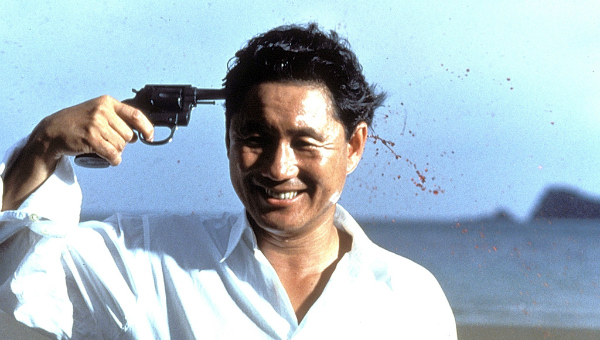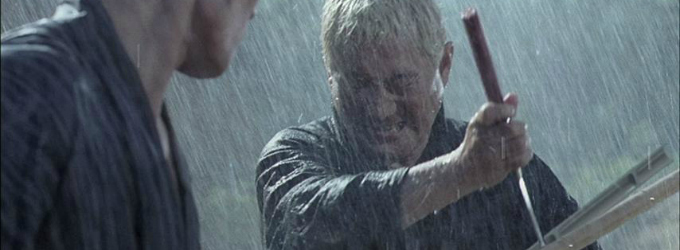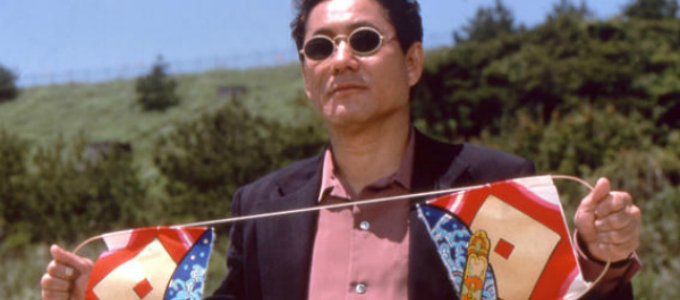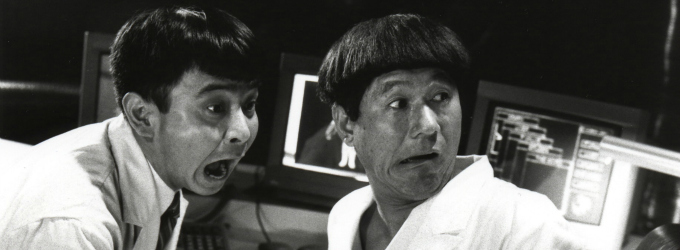httpvh://youtu.be/XoylyLvAhuI
When his reputation as a comedian led to the box office flopping of SONATINE, now one of his most acclaimed films, Takeshi Kitano’s initial reaction was to attempt suicide. He knew that Akira Kurosawa had reacted in the same way following the critical failure of DODESUKADEN, a film set on a rubbish dump. Once Kitano had recovered from his “motorcycle accident”, his second reaction to this career setback was to risk glorious professional suicide with a film which would be widely described as, and whose climax would feature literally, a pile of shit. MINNĀ YATTERU KA!? (“Getting Any?”) exudes all the joyful exasperation and defiance of Uwe Boll’s POSTAL, a piece which challenged critics to “put up or shut up”. Where Boll takes for inspiration bloody videogames, Kitano aimed to create with his game show “Takeshi’s Castle” a “live action Super Mario game”, and MINNĀ YATTERU KA!? scampers over the same comic minefield.
… some fans find it difficult to reconcile the fool king with the swordsman …
Kitano retains the nickname “Beat” from his celebrated Manzai performance as half of “The Two Beats”, a fast-talking Japanese comedy duo comparable to Geordie monkey business partners Ant and Dec. He identifies himself primarily as a comedian to this day. Yûrei Yanagi, who also appeared in HANA-BI, both JU-ONs and RINGUs, appears as Masaki in 3-4 X JÛGATSU (“Boiling Point”). Minoru “Dankan” Iizuka co-stars in this film as Masaki’s friend Kazuo, and also stars as Asao in MINNĀ YATTERU KA!?. Both are Kitano stalwarts and members of Office Kitano. Yanagi’s terrific long face and Dankan’s Mike Myers-ish toddler-face draw their spirit from Kyogen, the mischievous, mask-less brother to Noh theatre. Although some fans find it difficult to reconcile the fool king with the swordsman, it’s through Kitano’s early light entertainment work that he developed the artistic and directorial sensibility which allowed his development as a serious film actor and director.
Kitano’s narrative arcs are always solid, and yet his films focus more on the moments between obvious plot points – the incidental moments being more important than the key incidents. This approach invites comparison to Tarantino, who cites him as a great influence. Kitano became embarrassed when first asked about his own influences, was forced to confess that he did not have a substantial reference library, and vowed to bone up. He judged each film that he watched in its own right, quite reasonably reluctant to identify a single auteur whose every creation he admired. He rather looks to his own past works for inspiration, spurred by his own mistakes.
The long beats of Jarmusch or Hartley can be pregnant, alienating and stylish; Kitano’s are immediate, immersive and substantial.
The Hollywood film industry often attracts the mercenary and the egotistical, and allows too many cooks to influence a project. Japanese film makers are more likely to be self-critical craftsmen who have editorial control over their films, and who show pride in their work, not so much in themselves. The slow, steady rhythm of some of Beat’s films are comparable to the “neo-Beat” style of Jarmusch. The long beats of Jarmusch or Hartley can be pregnant, alienating and stylish; Kitano’s are immediate, immersive and substantial. This is the way that Kitano communicates in interview – longueurs can be a natural part of Japanese intercourse, misinterpreted by the Westerner who is used to filling silences with the phatic and the fatuous.
The rich ambient sound and depth of field characteristic to Kitano’s aesthetic creates a languorous and meditative realism. A three dimensional impression is created in different ways – a character will run back and forth into the eye of the camera like a Muppet, or a drunken fish-eye lens will shift emphasis on a character by having them shrink on the sideline and then loom into centre stage. More often, the effect is achieved through a simple diorama of well-executed composition and perspective, especially on the sea shore. Here, Kitano’s trademark beach scenes invite speculation as to the use of the ocean as a metaphorical device. For instance, all life forms originated in the sea – and hundreds of millions of years later, in 3-4 X JÛGATSU, Kazuo wades back into the sea to wash his bum. One can ascribe human emotions to the sea and find parallels in a film’s destructive characters. However, the most important reason that a Japan shoot finds Kitano on the beach is that it’s the only place on these small land masses where he’s unlikely to run into a bunch of fans.
Now a marked man, he is roused from apathy to mild irritation when the Yakuza begin to harass his colleagues.
You can escape a cycle of lassitude but you can’t escape a cycle of violence. In 3-4 X JÛGATSU Masaki plays baseball and works at a gas station, but his heart is in neither endeavour. The opening of the film finds him dallying in a portaloo at the edge of the baseball pitch. He emerges, steps up to the plate and drops the ball, and this forms the pattern for his life. Numb to the cat-calls of his fellow players, he finally achieves “Boiling Point” when intimidated by a member of the Yakuza at the garage. Now a marked man, he is roused from apathy to mild irritation when the Yakuza begin to harass his colleagues. His baseball coach, a former Yakuza, sends him and his friend to Okinawa to get a gun. The Okinawa contact is a Uehara, a character created by Kitano as a catalytic converter for himself: an antithesis to his funnyman persona.
As much a misfit as Masaki, Uehara is a force of understated and unpredictable nature in a Scarface shirt, whose acts of violence are rendered all the more fearsome by his apparent lack of passion. His raping is just rutting; his killing is just exaggerated petulance. He has car sex with his girlfriend, and later kicks and cuffs her as though they were two siblings strapped to the back seat on a long journey.
Asao makes important life decisions in an Oriental squatting pose that calls to mind Oor Wullie philosophising on a bucket.
Okinawa is known for its flower and butterfly gardens – Uehara gathers fiery “bird of paradise” flowers from a field, because he plans to hide a gun in a bouquet, a symbolic “fire flower” precursor to HANA-BI. Later on, he will send butterfly eggs to Masaki, compounding his character as the symbol of artistic evolution for Kitano – caterpillar to butterfly, comedian to villain. When he and the two heroes part ways, a brief barrage of scenes assault the stoic Uehara, predicting the remaining events of his life, and then his death. Does this represent his conscious agenda? Is it precognition, or predestination? It is a powerful scene, reminiscent of the “multiple outcomes” conceit that is central to Tom Tykwer’s RUN LOLA RUN. Okinawa is also known for tetsu no ame, the civilian suicides enforced by the Japanese military when faced with US opposition in the Second World War. Kitano’s enigmatic preoccupation with suicide insinuates its way into the narrative just as the Coke and Metallica ads peep from the facades on the streets of 3-4 X JÛGATSU’s Okinawa.
Asao, the hero of MINNĀ YATTERU KA!? is the universal trickster/culture hero, the everyman, or more accurately the everybody whose British incarnation can be found in D.C. Thomson publications such as Beano and Dandy. Asao makes important life decisions in an Oriental squatting pose that calls to mind Oor Wullie philosophising on a bucket. The word Yatteru is derived from an informal Japanese word meaning “do” – and every school child knows what “doing it” is. Is everyone “doing it”?! Asao touches the lives of many bonkers characters in the course of his scheming, including a suicidal, bankrupt salaryman, whom he entrusts with a cake, steals it and presents it to his family, only for it to explode.
Asao is led by pop media and advertising to think of women as creatures who must be baited with fame, power or money.
With this film Kitano wanted to take the cake even if it meant the film bombed. It is a purging of frustration which paved the way for his later revered works, and he looks back to it with affection and appreciation as a piece of artistic rejuvenation. He plays with the comic deus ex machina, using recurring devices such as a dying gangster bequeathing the bemused hero with just the items he happens to require at that moment. Asao is led by pop media and advertising to think of women as creatures who must be baited with fame, power or money. His Viz-esque scheming finds him so caught up in situations that parody the film industry, gangland culture and samurai cliché that he often seems to forget his goal. Much may be lost in translation to non-Japanophiles, as this is a string of mostly Japanese references to pop culture icons such as “Oh, Mikey!”, Godzilla, “Lone Wolf and Cub” and Ultraman.
httpvh://youtu.be/BHsWokO35jA
However, each homage is hinted at by a musical motif and most 80s-literate Westerners will spot spoof scenes such as GHOSTBUSTERS and Michael Jackson’s “Beat It” video. The Invisible Man and the Fly Man parodied here are Japanese, albeit distant cousins of the characters from Western film mythology. If you didn’t attend Japanese school as a child, you won’t have been forced to endure Osamu Dazai’s classic and stuffy moral tale “Run, Melos!”, but you can still appreciate the gag where a boffin can knock people unconscious by quoting a single line. Anyone who loves Tex Avery, Mel Brooks or National Lampoon, and is prepared to accept that Kitano is at heart a silly and funny man, will appreciate the spirit of MINNĀ YATTERU KA!?.
The protagonists of both films are as stony-faced as Beckett’s tramps, but their apparent passivity belies their struggle to identify and actively pursue their Godot.
The subtle watercolour of 3-4 x jûgatsu and the Lego rainbow of MINNĀ YATTERU KA!? both look at the rite of passage from different angles, and both see the same problem. Asao blithely sells his grandfather’s liver and kidney, and later poohs on his mother’s face. Masaki becomes closely involved with a man who dispassionately shoots The Godfather and beats women. And to what end? 3-4 X JÛGATSU and MINNĀ YATTERU KA!? are both landmarks in Kitano’s directing career: his arrival and his comeback. Both films have a self-destructive theme – whether it’s the ego or the body that is being destroyed. From kamikaze pilots to self-immolating Buddhists, Kitano says that the Japanese see romantic redemption in suicide. The 3-4 X JÛGATSU baseball chums and the MINNĀ YATTERU KA!? loser Asao are both looking for the big secret that everyone else is keeping from them, for the meaning of life. The heroes of both films feel as though they are alone in having no sense of purpose or currency, and so they react in different adolescent ways, whether it’s a spiritual hunger-strike or a febrile mission to make out. The protagonists of both films are as stony-faced as Beckett’s tramps, but their apparent passivity belies their struggle to identify and actively pursue their Godot.
Kitano has said that he strives to be “ungraspable”, and his films show that all parts of life can be wildly elusive. The “Grasshopper” man of the post-credits scene in MINNĀ YATTERU KA!? impales himself on the Tokyo Tower like a butterfly on a pin but keeps on trying to hop – you might try to pin the ungraspable spirit down but it will never be suffocated.





